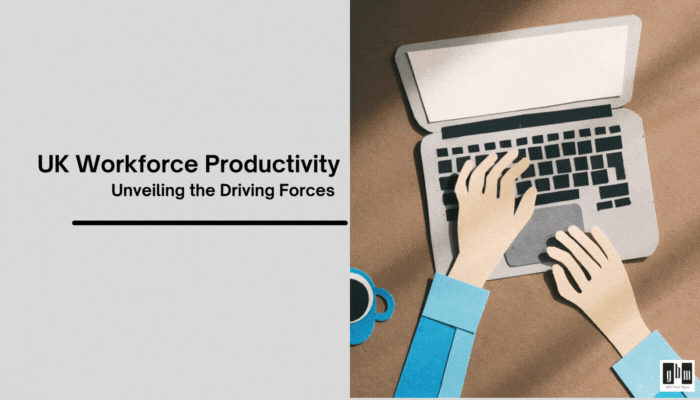Unlocking the Potential: Delving into Employee Productivity in the UK

The Thrumming Pulse of Productivity
In the bustling arena of business, where every heartbeat resonates with the rhythm of productivity, the United Kingdom finds itself navigating a distinctive challenge. While witnessing overall growth, the UK’s labor productivity trails behind several major economies. This article delves into the current state, illuminates emerging trends, and provides valuable insights for businesses navigating this dynamic landscape in 2024.
Dissecting the Landscape
A Glimpse into the Numbers: As of October-December 2023, the Office for National Statistics (ONS) reports an output per hour worked value of £46.92 in the UK. This represents a 2.0% increase compared to pre-pandemic levels in the same quarter, demonstrating gradual improvement. However, there’s still room for significant enhancement.
Uneven Distribution: A concerning trend emerges upon scrutinizing productivity distribution across the nation. London and the South-East remain productivity powerhouses, overshadowing other regions and highlighting a worrisome geographical divide. The latest data from ONS reveals London with an average gross value added per hour of £43.12, significantly higher than the national average and almost double that of Wales (£28.6).
Firm-Level Disparity: Within the workforce lies a significant gap between high-performing and low-performing firms. While top performers dazzle with their impressive output, a substantial portion of the workforce grapples with productivity challenges within less efficient companies. Addressing this disparity is crucial for inclusive and sustainable economic growth.
The Looming Skills Gap: Hovering on the horizon is the specter of a skills gap. This challenge impedes the seamless adoption of new technologies and innovative practices, potentially stifling potential productivity gains. Investing in upskilling and reskilling initiatives is essential to bridge this gap and equip the workforce with the necessary skills to thrive in the evolving world of work.
Comparison of Output per Hour Worked in Different Countries 2024
| Metric | UK | USA | Germany | France | Japan |
|---|---|---|---|---|---|
| Output per hour worked (£) | 46.92 | 63.00 | 58.50 | 52.10 | 44.00 |
| Year-on-year change (%) | -0.60 | 2.30 | 1.10 | 1.50 | -1.20 |
| Productivity compared to pre-pandemic levels (%) | 2.00 | 4.80 | 3.50 | 2.70 | -0.40 |
The table presents key metrics of labor productivity across selected countries, including the UK, USA, Germany, France, and Japan. Output per hour worked, year-on-year changes, and productivity compared to pre-pandemic levels offer insights into each country’s economic performance and recovery trajectory amidst the challenges posed by the COVID-19 pandemic.
Emerging Trends and Insights for 2024
The Hybrid Work Revolution: A seismic shift is underway with the ascent of hybrid work arrangements. While studies offer mixed results regarding the impact on productivity, crafting effective strategies for fostering seamless communication, collaboration, and well-being in this new landscape remains imperative for organizations.
Prioritizing Well-being: Recognizing the intrinsic link between employee well-being and productivity, organizations are poised to invest in initiatives championing mental and physical health. Such investments promise heightened employee engagement, reduced absenteeism, and ultimately, a surge in productivity.
Technology as a Catalyst: The relentless march of technology continues unabated, offering a plethora of opportunities to streamline processes and boost worker efficiency. However, the human element must not be overlooked. Managing the transition, addressing potential challenges, and ensuring responsible implementation of technology are paramount.
Upskilling the Workforce: Bridging the skills gap remains a cornerstone for long-term productivity growth. This necessitates a concerted effort towards fostering digital literacy, upskilling existing talent, and attracting fresh blood armed with in-demand skills.
Navigating the Future: A Roadmap to Success
For UK businesses to chart a course towards sustained success, a laser focus on the following facets is critical:
Embrace Flexible Work Models: Crafting robust policies and practices to navigate the terrain of hybrid work environments is crucial. Effective communication, seamless collaboration, and unwavering productivity should remain at the forefront of organizational strategies.
Prioritize Employee Well-being: Cultivating a culture that prioritizes employee well-being lays the foundation for a resilient and high-performing workforce. Initiatives promoting a healthy work-life balance and addressing well-being concerns are instrumental in fostering a supportive work environment.
Invest in Technology Strategically: The strategic integration of technology serves as a potent catalyst for process optimization and employee empowerment. However, a judicious approach coupled with effective change management is essential to ensure a smooth transition and mitigate potential hurdles.
Commit to Continuous Learning: The journey towards productivity excellence hinges on the continuous development of skills and knowledge within the workforce. Organizations must remain steadfast in their commitment to upskilling and reskilling initiatives, fortifying their competitive edge and remaining agile in the face of evolving demands.
Employee productivity in the UK paints a tapestry of complexity and dynamism. While challenges loom large on the horizon, a tapestry of exciting trends and opportunities unfurls before us. By embracing the current state, deciphering emerging trends, and taking proactive measures outlined above, businesses can unlock the latent potential of their workforce and carve a path towards sustained success in 2024 and beyond.
Factors Potentially Influencing UK Worker Productivity
| Factor | Description | Potential Impact on Productivity |
|---|---|---|
| Flexible work arrangements (e.g., 4-day work week) | Increased work-life balance, reduced commuting time, enhanced well-being | Potential 10% increase in productivity |
| Prioritized well-being | Initiatives promoting mental health support, healthy work-life balance, and positive work environment | Higher engagement, reduced absenteeism, and increased productivity |
| Effective use of technology | Streamlined processes, boosted efficiency, and empowered workers | Improvement in overall productivity |
| Upskilled workforce | Bridging the skills gap and equipping with in-demand skills | Long-term growth in productivity |
| Employee recognition and reward | Acknowledging and rewarding outstanding performance | Motivation, sense of accomplishment, and improved productivity |
What are some of the main factors contributing to the productivity gap between regions in the UK, and how can businesses address these disparities effectively?
The productivity gap between regions in the UK can be attributed to various factors such as differences in infrastructure, access to talent, and industry specialization. Businesses can address these disparities by investing in infrastructure development in less productive regions, implementing targeted skills development programs, and fostering collaboration between businesses and local governments to support economic growth outside of major urban centers.
How do hybrid work models impact employee productivity in the UK, and what strategies can businesses implement to maximize productivity in this new work environment?
Hybrid work models can have both positive and negative impacts on employee productivity in the UK. While they offer flexibility and work-life balance, they also present challenges related to communication, collaboration, and maintaining a cohesive company culture. To maximize productivity in this new work environment, businesses can implement strategies such as establishing clear communication channels, providing training on remote work best practices, and leveraging technology to facilitate virtual collaboration and engagement.
What role does employee well-being play in driving productivity levels in UK workplaces, and how can organizations prioritize and support employee well-being effectively?
Employee well-being is closely linked to productivity levels in UK workplaces, as happy and healthy employees are more engaged, motivated, and productive. Organizations can prioritize and support employee well-being effectively by offering flexible work arrangements, promoting work-life balance, providing access to mental health resources and support programs, and fostering a culture of open communication and support.
How are UK businesses leveraging technology to enhance employee productivity, and what are some best practices for integrating technology into the workplace to achieve optimal results?
UK businesses are leveraging technology to enhance employee productivity through tools and platforms that streamline processes, automate repetitive tasks, and facilitate remote collaboration. Some best practices for integrating technology into the workplace include conducting thorough training and onboarding for employees, ensuring data security and privacy compliance, and regularly evaluating and updating technology solutions to meet evolving business needs.
What initiatives are being implemented in the UK to address the skills gap and enhance workforce productivity, and what role do upskilling and reskilling programs play in this process?
In the UK, initiatives to address the skills gap and enhance workforce productivity include government-funded training programs, partnerships between businesses and educational institutions, and industry-led initiatives to promote lifelong learning and skills development. Upskilling and reskilling programs play a crucial role in this process by providing employees with the necessary skills and knowledge to adapt to changing job roles and industry demands, ultimately enhancing overall workforce productivity.
Note: This article incorporates the latest data available from the Office for National Statistics (ONS) as of March 3, 2024.
















